Japan is a land where ancient traditions harmoniously blend with cutting-edge technology, creating an enchanting destination that captivates travelers from across the globe.
From the neon-lit streets of Tokyo to the serene temples of Kyoto, Japan offers a travel experience unlike any other.
The country’s unique cultural identity, exquisite cuisine, breathtaking landscapes, and unparalleled hospitality make it a must-visit destination for travelers seeking both adventure and tranquility.
Getting to Japan might seem daunting at first, especially for those traveling from distant countries, but with proper planning and information, your journey can be smooth and stress-free.
Whether you’re dreaming of witnessing cherry blossoms in spring, exploring ancient castles, experiencing the vibrant city life, or immersing yourself in traditional Japanese culture, understanding your travel options is the crucial first step to turning these dreams into reality.
This comprehensive guide aims to demystify the process of traveling to Japan by providing you with all the essential information you need.
From finding the best flight options to understanding entry requirements and navigating the country’s efficient transportation system, we’ve got you covered.
Our goal is to equip you with the knowledge and confidence to plan your journey to the Land of the Rising Sun without any uncertainties or complications.
What makes Japan worth the journey? Beyond its iconic attractions like Mount Fuji and the historic temples of Nara, Japan offers experiences that appeal to every type of traveler:
- Cultural richness: Experience centuries-old traditions alongside modern innovations
- Culinary excellence: Savor world-renowned cuisine from high-end sushi to street food
- Natural beauty: Explore diverse landscapes from tropical islands to snow-capped mountains
- Technological marvels: Witness futuristic cities and cutting-edge innovations
- Unmatched hospitality: Enjoy the legendary Japanese omotenashi (hospitality)
As you prepare for your Japanese adventure, this guide will serve as your trusted companion, helping you navigate every aspect of getting to this fascinating country. Let’s begin the journey of discovering how you can get to Japan and make your travel dreams come true.
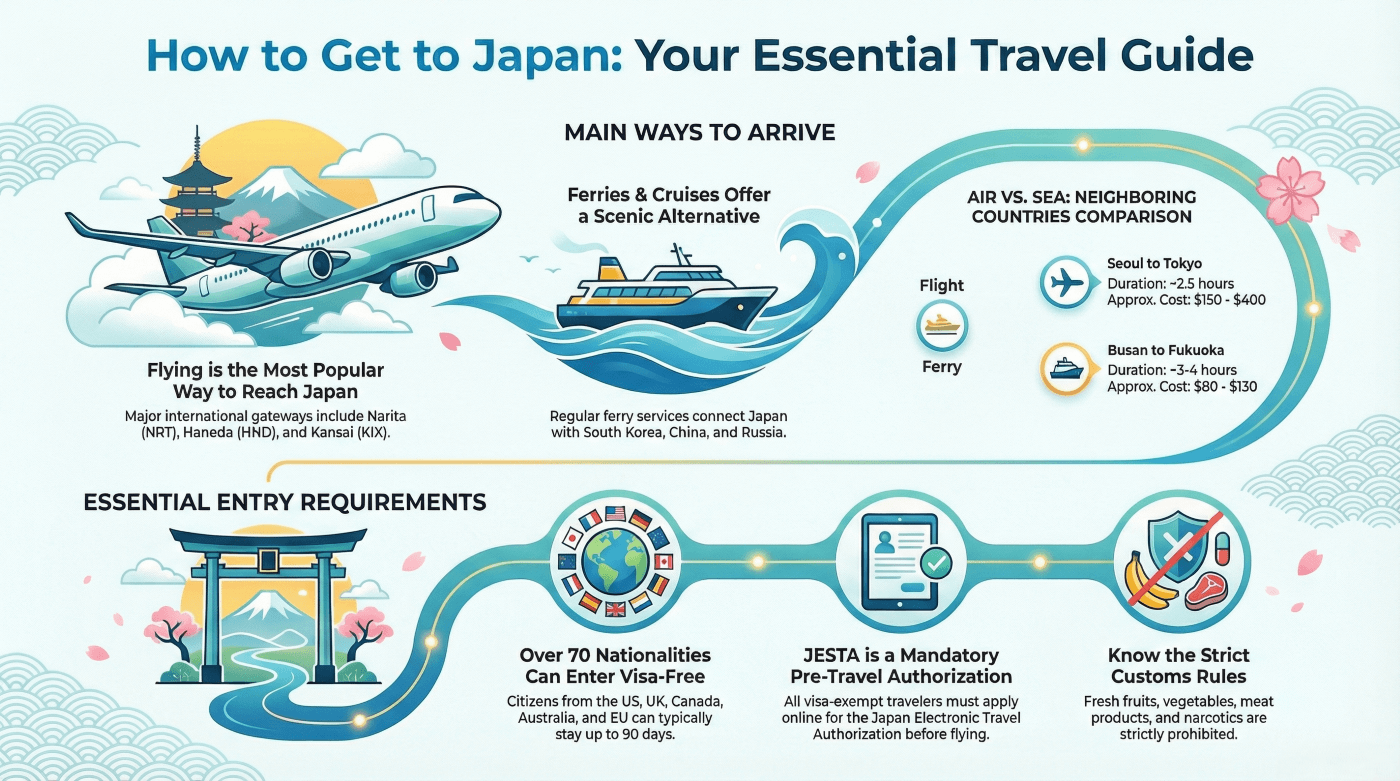
Getting to Japan by Air: Your Gateway to the Land of the Rising Sun
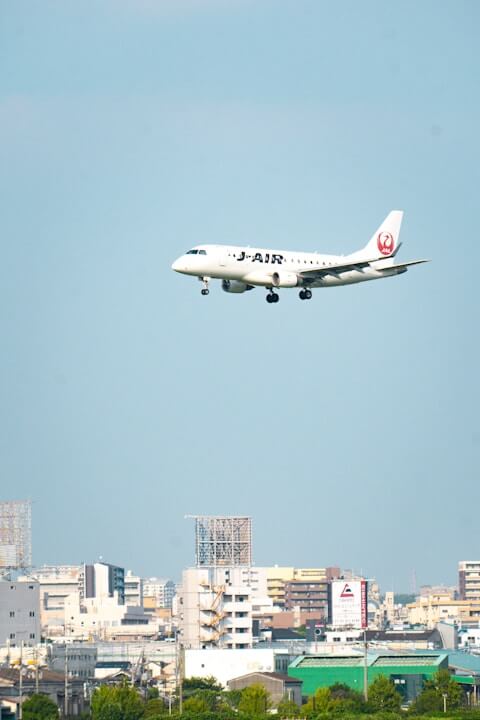
Japan’s strategic location in East Asia makes air travel the most practical and popular way to reach this island nation. With world-class airports and excellent international connections, flying to Japan is convenient from virtually anywhere in the world.
Major International Airports in Japan
Japan boasts several international airports that serve as primary entry points for foreign visitors:
Narita International Airport (NRT) – Located approximately 60 km east of central Tokyo, Narita remains Japan’s primary international gateway. This massive facility handles the majority of international flights to the Tokyo area and offers excellent connections to the city via train, bus, and taxi services. The airport features three terminals with comprehensive amenities including duty-free shopping, diverse dining options, and free Wi-Fi throughout.
Haneda Airport (HND) – Officially known as Tokyo International Airport, Haneda has become increasingly important for international travel. Located just 14 km from central Tokyo, it offers unparalleled convenience for accessing the capital. Many travelers prefer Haneda for its proximity to the city center and shorter transfer times. In recent years, Haneda has expanded its international flight offerings significantly.
Kansai International Airport (KIX) – Serving the Osaka, Kyoto, and Kobe region, Kansai International Airport sits on an artificial island in Osaka Bay. This architectural marvel provides a convenient entry point for visitors heading to western Japan. The airport is connected to the mainland by both train and bus services, making it easy to reach popular destinations like Kyoto (about 90 minutes away).
Chubu Centrair International Airport (NGO) – Located near Nagoya, this airport serves central Japan (hence the name “Chubu,” which means “central region”). Built on an artificial island in Ise Bay, Chubu Centrair provides excellent access to destinations like Nagoya, the Japan Alps, and the historic Takayama region.
Other notable international airports include Fukuoka Airport (FUK) in Kyushu and New Chitose Airport (CTS) in Hokkaido, both serving as regional gateways to these popular tourist destinations.
Direct Flight Routes from Major Global Cities
Japan is well-connected to major cities worldwide through direct flight routes:
| Region | Major Departure Cities | Airlines | Typical Flight Time |
|---|---|---|---|
| North America | Los Angeles, New York, Chicago, Vancouver, San Francisco, Seattle | JAL, ANA, United, American, Delta, Air Canada | 10-14 hours |
| Europe | London, Paris, Frankfurt, Amsterdam, Helsinki, Istanbul | JAL, ANA, British Airways, Air France, Lufthansa, KLM, Finnair, Turkish Airlines | 11-14 hours |
| Asia | Seoul, Beijing, Shanghai, Hong Kong, Singapore, Bangkok, Taipei | JAL, ANA, Korean Air, Air China, Cathay Pacific, Singapore Airlines, Thai Airways | 2-7 hours |
| Oceania | Sydney, Melbourne, Auckland | JAL, ANA, Qantas, Air New Zealand | 9-11 hours |
| Middle East | Dubai, Doha, Abu Dhabi | Emirates, Qatar Airways, Etihad | 10-12 hours |
Average Flight Durations and Costs
Flight durations to Japan vary significantly depending on your departure point:
- From North America: Expect flights from the West Coast (Los Angeles, Vancouver) to take approximately 10-12 hours, while East Coast departures (New York, Toronto) typically require 13-15 hours.
- From Europe: Direct flights from major European cities like London, Paris, or Frankfurt usually take between 11-14 hours.
- From Australia/New Zealand: Flights from Sydney or Auckland typically take 9-11 hours.
- From Asia: Regional flights are much shorter, with Seoul to Tokyo taking just 2-3 hours, and Southeast Asian cities like Bangkok or Singapore requiring 5-7 hours.
As for costs, economy class round-trip fares typically fall within these ranges:
- North America to Japan: $700-$1,500
- Europe to Japan: €600-€1,200
- Australia to Japan: AU$700-AU$1,500
- Asia to Japan: $300-$800
Pro tip: Flight prices to Japan can vary by up to 50% depending on when you book. Generally, booking 3-6 months in advance offers the best balance of availability and competitive pricing.
Budget Airlines Serving Japan
For budget-conscious travelers, several low-cost carriers offer more affordable options to reach Japan:
- Zipair – A budget subsidiary of Japan Airlines offering routes from select cities including Los Angeles, San Francisco, and Singapore
- Peach Aviation – Flies from various Asian cities including Seoul, Taipei, Hong Kong, and Bangkok
- Jetstar Japan – Connects Japan with select destinations in Asia
- Scoot – Offers flights from Singapore and other Southeast Asian cities
- AirAsia X – Connects Kuala Lumpur and other Asian hubs with Japan
While budget airlines typically offer lower base fares, be aware that they often charge extra for services like checked baggage, seat selection, and in-flight meals. Calculate the total cost including these add-ons when comparing with full-service carriers.
Seasonal Considerations for Booking Flights
Japan experiences distinct peak travel seasons that significantly impact flight availability and pricing:
- Cherry Blossom Season (late March to early April): Perhaps Japan’s most popular tourist season, flights during cherry blossom time should be booked 6-9 months in advance.
- Golden Week (late April to early May): This cluster of Japanese holidays creates enormous domestic travel demand. International flights during this period are both expensive and quickly booked.
- Summer Vacation (July-August): Coinciding with school holidays worldwide, summer sees high demand and higher prices.
- Autumn Foliage Season (November): Another popular time for tourism as Japan’s landscapes transform with fall colors.
- New Year Holidays (late December to early January): Extremely busy period for travel to and within Japan.
The most budget-friendly times to fly to Japan are typically:
- Late January through February (excluding Chinese New Year)
- Late May to June (rainy season in much of Japan)
- September to early December (excluding autumn foliage peak in November)
Insider tip: For the best combination of pleasant weather and reasonable airfares, consider traveling in late May/early June or late September/early October. These “shoulder seasons” offer a sweet spot of fewer crowds and more moderate prices while still providing enjoyable weather for sightseeing.
When planning your journey to Japan, booking your flight is just the beginning of what promises to be an unforgettable adventure in one of the world’s most fascinating destinations.
Also Read: Can You Buy JR Pass In Japan? & Where To Buy Sim Card In Japan?
Alternative Travel Options: Ferries and Cruises to Japan
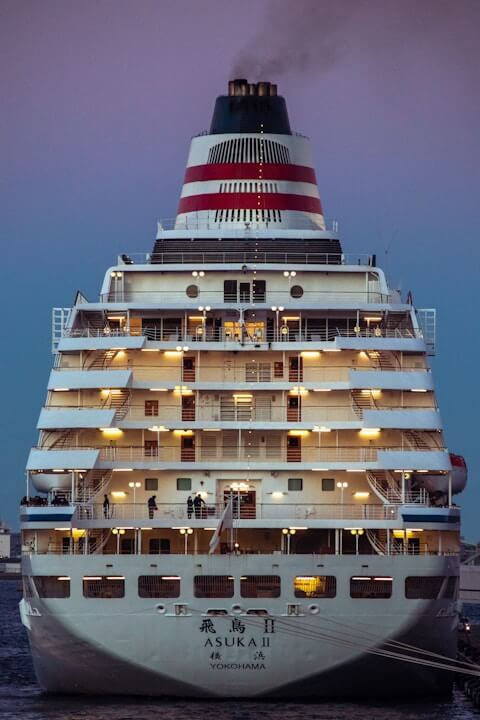
Japan’s island geography makes sea travel a fascinating alternative to flying. While air travel dominates international access to Japan, arriving by sea offers unique experiences and perspectives for travelers with more flexible schedules.
Ferry Routes from South Korea and Other Neighboring Countries
Several established ferry routes connect Japan with its closest neighbors, with South Korea offering the most regular services:
South Korea to Japan Routes:
- Busan to Fukuoka (Hakata): The most popular route, with daily high-speed hydrofoils making the crossing in approximately 3 hours
- Busan to Shimonoseki: Overnight ferries taking 11-12 hours, offering comfortable cabin accommodations
- Busan to Osaka: A longer journey of approximately 18 hours, typically operating 2-3 times weekly
China to Japan Routes:
- Shanghai to Osaka: Weekly ferries taking approximately 46 hours
- Tianjin to Kobe: Services operating 1-2 times weekly, journey time around 50 hours
Russia to Japan Routes:
- Vladivostok to Sakaiminato: Seasonal services (typically May-October) taking approximately 20 hours
Most ferries offer various accommodation options ranging from shared dormitory-style rooms to private cabins, along with restaurants, shops, and entertainment facilities for longer journeys.
Duration and Cost Comparison with Flights
While ferries take considerably longer than flights, they offer unique advantages:
| Travel Method | Route Example | Duration | Approximate Cost (USD) | Baggage Allowance |
|---|---|---|---|---|
| Ferry | Busan to Fukuoka | 3-4 hours | $80-130 | Generous (usually 2-3 bags included) |
| Ferry | Busan to Osaka | 18 hours | $130-250 | Generous (usually 2-3 bags included) |
| Flight | Seoul to Tokyo | 2.5 hours | $150-400 | Limited (typically 20-23kg) |
| Flight | Shanghai to Tokyo | 3 hours | $200-500 | Limited (typically 20-23kg) |
Cost Considerations:
- Ferry prices typically include accommodation for overnight journeys
- Ferries allow more baggage without extra fees
- Food costs on ferries can be lower than airport dining
- Flying often requires additional transportation to/from airports
Time Considerations:
- Ferries require significant time investment
- Check-in procedures for ferries are typically less time-consuming than airport security
- Sea travel eliminates jet lag for some travelers
Cruise Options for Visiting Japan
Beyond practical transportation, numerous cruise lines incorporate Japanese ports in their Asian itineraries:
Major Cruise Lines Serving Japan:
- Princess Cruises
- Royal Caribbean
- Celebrity Cruises
- Holland America Line
- MSC Cruises
Popular Cruise Itineraries:
- East Asia cruises connecting Japan with South Korea, China, and Taiwan
- Circle Japan cruises visiting multiple Japanese ports
- Transpacific cruises between North America and Japan
Cruises typically visit major port cities like Yokohama (Tokyo), Kobe, Nagasaki, Hakodate, and Fukuoka, offering organized excursions to nearby attractions.
Benefits of Sea Travel to Japan
Arriving in Japan by sea offers several unique advantages:
- Scenic Arrivals: Approaching Japan’s coastline by sea provides spectacular views of mountainous landscapes and bustling harbors
- Reduced Environmental Impact: Sea travel generally has a lower carbon footprint than flying
- Gradual Cultural Transition: The slower pace allows travelers to mentally prepare for cultural differences
- Unique Photography Opportunities: Capture distinctive perspectives of Japan’s coastline and port cities
- Avoiding Flight Anxiety: An excellent option for travelers who prefer to avoid flying
- Built-in Transportation and Accommodation: Overnight ferries and cruises combine travel and lodging costs
“Approaching Japan by sea gives you a perspective few modern travelers experience—you’re following the same routes used by merchants, diplomats, and adventurers for centuries.”
Key Ports and Terminals in Japan
Japan’s major international ferry and cruise terminals include:
Hakata Port (Fukuoka)
- Japan’s busiest international ferry terminal
- Modern facilities with duty-free shopping
- Excellent connections to Fukuoka’s subway system
- Located approximately 15 minutes from Fukuoka’s city center
Osaka International Ferry Terminal
- Serves routes from South Korea and China
- Connected to Osaka’s public transportation network
- Located in the Osaka Bay area, about 30 minutes from downtown
Yokohama Port
- Japan’s premier cruise ship terminal
- State-of-the-art facilities for international cruises
- Easy access to Tokyo (approximately 30-45 minutes by train)
- Historic port area with attractions within walking distance
Shimonoseki Port
- Gateway to western Japan
- Serves ferries from South Korea
- Historic significance as Japan’s connection to the Asian mainland
- Famous for its fresh seafood markets near the terminal
When planning sea travel to Japan, it’s advisable to book well in advance, particularly during peak travel seasons (spring cherry blossom season and autumn foliage).
Most ferry companies and cruise lines offer online booking with English-language options, making the process relatively straightforward for international travelers.
Also Read: How To Get A Job In Japan? & How To Get Work Visa In Japan?
Entry Requirements for Japan: Visas, Documentation & Customs
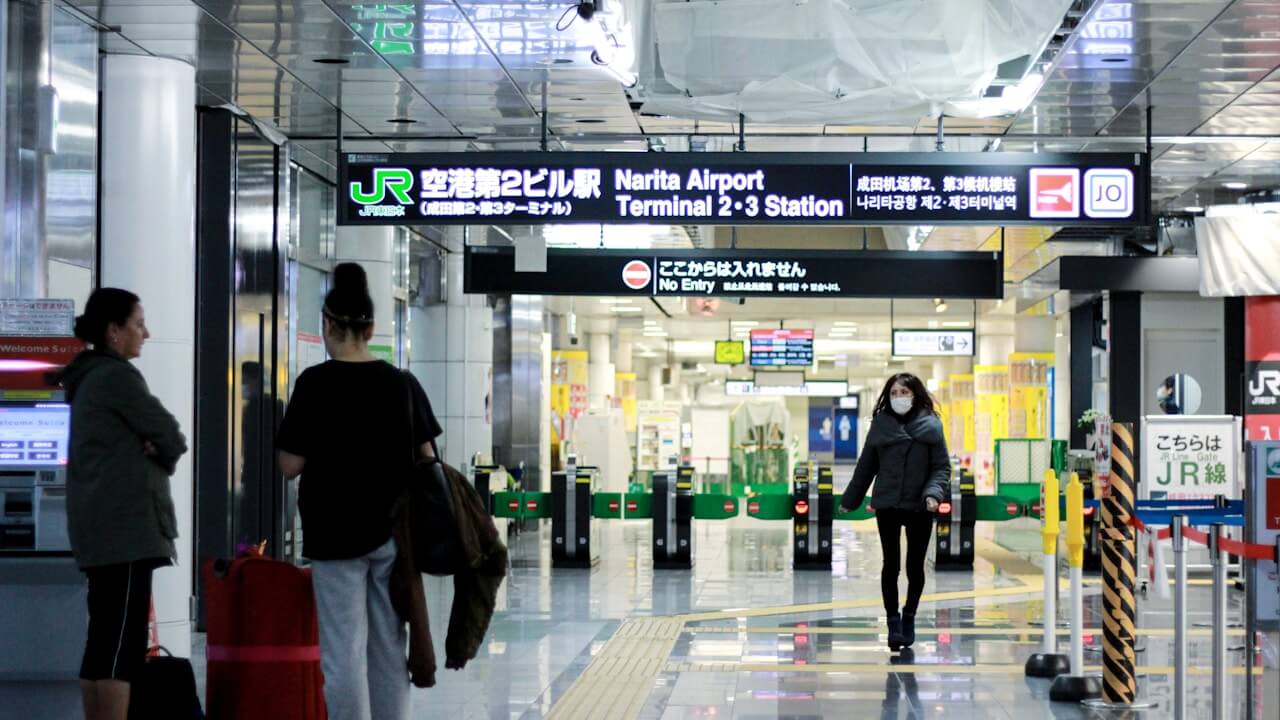
Japan welcomes millions of international visitors each year, but before packing your bags, it’s essential to understand the entry requirements.
Depending on your nationality, travel purpose, and length of stay, you may need to obtain a visa or meet specific documentation requirements.
Visa Requirements by Nationality
Japan’s visa policy varies significantly based on your passport:
| Nationality | Visa Requirement | Maximum Stay (Tourist) |
|---|---|---|
| United States | Visa-free | 90 days |
| United Kingdom | Visa-free | 90 days |
| Canada | Visa-free | 90 days |
| Australia | Visa-free | 90 days |
| EU Countries | Visa-free | 90 days |
| South Korea | Visa-free | 90 days |
| China | Visa required | Varies by visa type |
| Philippines | Visa required | Varies by visa type |
| India | Visa required | Varies by visa type |
| Russia | Visa required | Varies by visa type |
Pro Tip: Check the Ministry of Foreign Affairs of Japan website for the most current visa information for your specific nationality, as requirements can change.
For citizens of countries not eligible for visa-free entry, you’ll need to apply for a tourist visa through the Japanese embassy or consulate in your home country. The application process typically requires:
- A valid passport
- Completed visa application form
- Recent passport-sized photograph
- Itinerary or flight reservation
- Proof of financial means
- Letter of guarantee (in some cases)
Japan’s Visa Waiver Program
Japan’s visa waiver program allows citizens from approximately 70 countries and regions to enter Japan without a visa for short-term stays, typically for tourism, business, or visiting friends and relatives.
Key points about the visa waiver program:
- Duration: Generally allows stays of up to 90 days
- Purpose: Limited to temporary visits (tourism, business meetings, visiting family)
- No extensions: The period cannot typically be extended while in Japan
- No work allowed: Working on a tourist entry is prohibited and may result in deportation
If you plan to study, work, or stay longer than the visa-free period allows, you must apply for the appropriate visa before arriving in Japan.
Japan Electronic Travel Authorization (JESTA)
Starting in 2024, Japan introduced the Japan Electronic Travel Authorization (JESTA) system for visa-exempt travelers.
Similar to systems like ESTA (US) or eTA (Canada), JESTA is a pre-screening system designed to enhance border security.
How JESTA works:
- Application: Complete the online application at least 24 hours before departure
- Fee: Pay a small processing fee (approximately ¥1,000 or $7 USD)
- Approval: Receive electronic authorization linked to your passport
- Validity: JESTA remains valid for multiple entries over a 3-year period or until passport expiration
JESTA is mandatory for all travelers eligible for visa-free entry and must be obtained before boarding your flight to Japan.
Required Documentation Upon Arrival
When arriving in Japan, be prepared to present the following to immigration officials:
- Valid passport with at least 6 months validity beyond your planned departure date
- Completed disembarkation card (typically distributed during your flight)
- JESTA approval (for visa-exempt travelers)
- Proof of onward travel (return or onward ticket)
- Proof of sufficient funds for your stay (credit cards, cash, bank statements)
- Accommodation details (hotel reservations or address where you’ll be staying)
Immigration officials may ask about your travel plans, so be prepared to explain the purpose and duration of your visit.
Customs Regulations and Restrictions
After clearing immigration, you’ll proceed through Japanese customs. Be aware of these important regulations:
Duty-Free Allowances:
- Alcohol: 3 bottles (760ml each) of spirits, wine, or other alcoholic beverages
- Tobacco: 400 cigarettes or 100 cigars or 500g of tobacco
- Perfume: 2 ounces (60ml)
- Other items: Goods worth up to ¥200,000 (approximately $1,300 USD)
Strictly Prohibited Items:
- Narcotics and illegal drugs
- Firearms and ammunition
- Counterfeit goods
- Obscene materials
- Fresh fruits, vegetables, and meat products
- Endangered species and products made from them
Restricted Items Requiring Permits:
- Medications containing stimulants or psychotropic substances
- More than ¥1,000,000 (approximately $6,500 USD) in cash or equivalent
- Plants, seeds, and soil
- Animals and animal products
Important: Prescription medications containing controlled substances require advance permission through a “Yakkan Shoumei” certificate. Apply at least two weeks before your trip through the Ministry of Health, Labour and Welfare.
All travelers must complete a customs declaration form, declaring any items that exceed duty-free allowances or fall under restricted categories. False declarations can result in significant penalties, including fines and potential entry bans.
Understanding these entry requirements will help ensure a smooth arrival in Japan and allow you to begin your Japanese adventure without unnecessary complications.
Also Read: Can You Get Tattooed In Japan? & What Age Can You Get Married In Japan?
Getting from Japan’s Airports to Your Destination
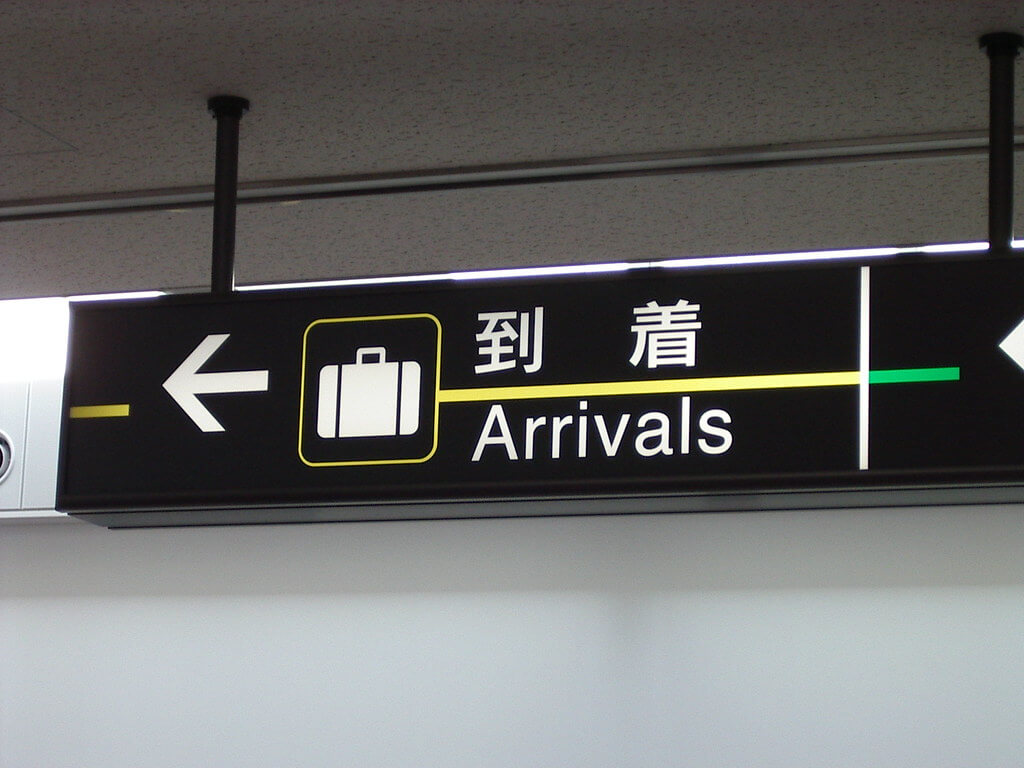
Arriving at a Japanese airport is just the first step of your journey. Japan’s efficient transportation network offers multiple ways to reach your final destination, whether it’s downtown Tokyo, historic Kyoto, or the beaches of Okinawa.
Transportation Options from Major Airports to City Centers
Japan’s major international airports all offer excellent connections to nearby cities:
Narita International Airport (NRT)
- Narita Express (N’EX): The premium option connecting Narita to major stations in Tokyo in about 60 minutes.
- Keisei Skyliner: A fast train reaching Ueno Station in just 41 minutes.
- Limousine Buses: Direct service to major hotels and stations throughout Tokyo.
- Regular Trains: Budget-friendly options on the Keisei Main Line or JR Lines.
Haneda Airport (HND)
- Tokyo Monorail: Connects to Hamamatsucho Station in about 15 minutes.
- Keikyu Line: Reaches Shinagawa Station in approximately 15 minutes.
- Limousine Buses: Direct connections to major areas and hotels.
Kansai International Airport (KIX)
- Haruka Express: High-speed train to Osaka Station (50 minutes) and Kyoto (75 minutes).
- Nankai Rapi:t: Limited express train to Namba Station in central Osaka (40 minutes).
- Airport Limousine Buses: Direct service to various destinations in the Kansai region.
Chubu Centrair International Airport (NGO)
- Meitetsu Airport Line: Rapid service to Nagoya Station in just 30 minutes.
- Limousine Buses: Connections to major destinations in the Chubu region.
Express Trains and Bus Services
Express Train Advantages:
- Speed: Often the fastest option, bypassing road traffic
- Reliability: Punctual schedules with minimal delays
- Comfort: Spacious seating with luggage storage
- Views: Scenic routes offering first glimpses of Japan
Limousine Bus Benefits:
- Convenience: Door-to-door service to major hotels
- Comfort: No need to transfer with heavy luggage
- Accessibility: Easier for travelers with mobility issues or excessive baggage
- Views: Higher vantage point for sightseeing
Costs and Durations
| Airport | Transportation | Duration | Cost (¥) | Best For |
|---|---|---|---|---|
| Narita | Narita Express | 60 min | 3,070 | Comfort, speed |
| Narita | Keisei Skyliner | 41 min | 2,570 | Speed to Ueno area |
| Narita | Limousine Bus | 75-120 min | 3,100 | Hotel direct access |
| Narita | Regular Train | 90-120 min | 1,030-1,340 | Budget travelers |
| Haneda | Monorail | 15 min | 500 | Quick access to JR lines |
| Haneda | Keikyu Line | 15 min | 300 | Budget option to Shinagawa |
| Haneda | Limousine Bus | 30-45 min | 1,030-1,130 | Direct hotel access |
| Kansai | Haruka Express | 50-75 min | 3,030 | Speed to Osaka/Kyoto |
| Kansai | Nankai Rapi:t | 40 min | 1,430 | Access to south Osaka |
| Chubu | Meitetsu Line | 30 min | 870 | Quick access to Nagoya |
Pro Tip: Purchase express train tickets in advance to secure seats, especially during peak travel seasons. Many tickets can be bought online before arriving in Japan.
When to Use Taxis vs. Public Transport
Choose Taxis When:
- Traveling with multiple large luggage pieces
- Arriving very late at night when some public transportation options are unavailable
- Traveling with young children or elderly companions
- Staying at accommodations not easily accessible by public transit
- Willing to pay for convenience (expect ¥15,000-25,000 from Narita to Tokyo)
Choose Public Transportation When:
- Traveling light or with manageable luggage
- Arriving during daytime hours
- Looking to save money
- Staying near major stations
- Wanting to experience Japan’s world-class public transportation system
Airport Amenities and Services
Japanese airports offer exceptional services to make your arrival smoother:
Currency Exchange & ATMs
- Multiple currency exchange counters with competitive rates
- International-friendly ATMs accepting foreign cards
Luggage Services
- Delivery Services: Send luggage directly to your hotel (takuhaibin)
- Temporary Storage: Short-term luggage lockers and storage counters
- Luggage Carts: Free throughout the terminals
Information Centers
- Multilingual staff providing transportation advice
- Free maps and guides
- Hotel booking assistance
- SIM card and pocket WiFi rental counters
Other Convenient Services
- Free WiFi throughout terminals
- Prayer rooms and nursing rooms
- Shower facilities for refreshing after long flights
- Observation decks for aircraft viewing
- Extensive dining and shopping options
Travel Insight: If you plan to use Japan Rail Pass, you can exchange your voucher at the JR offices located in major international airports. This allows you to use your pass immediately for airport express trains where applicable.
Japan’s efficient airport connections make the transition from air travel to your final destination remarkably smooth, setting the tone for the exceptional transportation experience you’ll enjoy throughout your Japanese adventure.
Also Read: Can You Get Flight From Japan To Nevada? & Get A Flight From Japan To Arizona
Navigating Japan’s Extensive Transportation Network
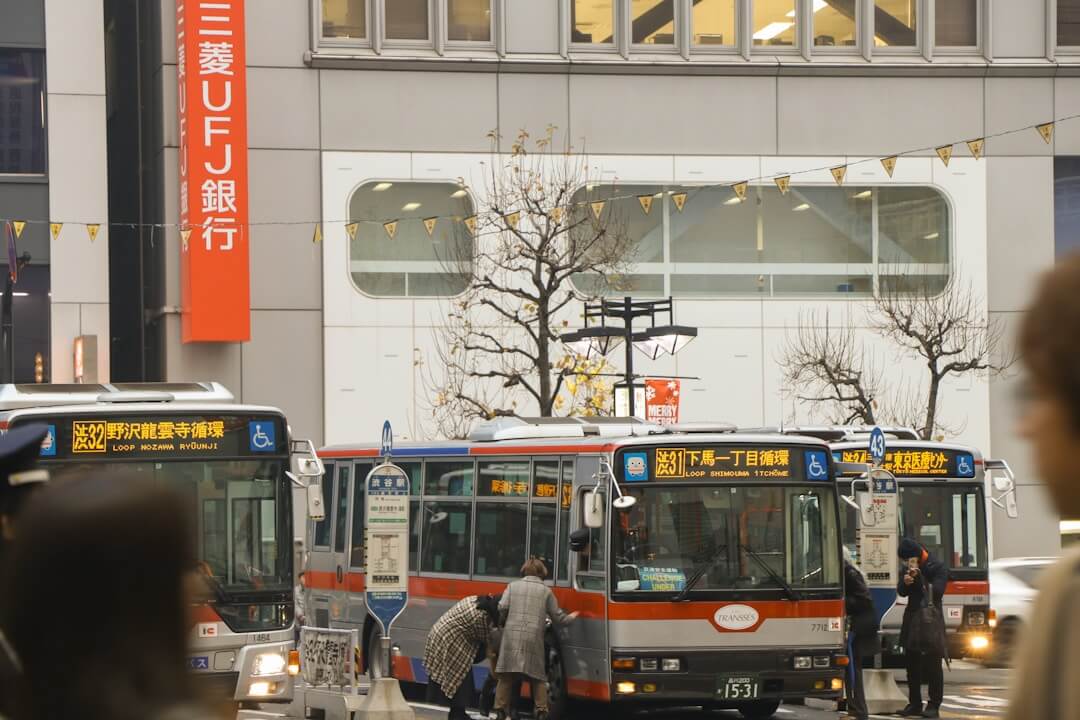
Japan boasts one of the world’s most efficient and comprehensive transportation systems, making travel within the country remarkably convenient once you’ve arrived.
Whether you’re planning to explore multiple regions or focus on a specific area, understanding your transportation options will help you maximize your time and budget.
The Legendary Shinkansen (Bullet Train) System
The Shinkansen is Japan’s world-renowned high-speed rail network, connecting major cities with trains that travel at speeds of up to 320 km/h (200 mph). This iconic transportation system is often the highlight of many travelers’ experiences in Japan.
The Shinkansen network consists of several lines:
| Line Name | Route | Notable Stops |
|---|---|---|
| Tokaido Shinkansen | Tokyo to Osaka | Yokohama, Nagoya, Kyoto |
| Sanyo Shinkansen | Osaka to Hakata (Fukuoka) | Kobe, Hiroshima |
| Tohoku Shinkansen | Tokyo to Aomori | Sendai, Morioka |
| Hokkaido Shinkansen | Aomori to Hakodate | Shin-Hakodate-Hokuto |
| Joetsu Shinkansen | Tokyo to Niigata | Takasaki, Echigo-Yuzawa |
| Kyushu Shinkansen | Hakata to Kagoshima | Kumamoto |
The Shinkansen is known for its:
- Punctuality: Trains typically arrive and depart within seconds of their scheduled times
- Comfort: Spacious seating, clean facilities, and smooth rides
- Frequency: Departures every few minutes on major routes during peak hours
- Safety: Perfect safety record with zero passenger fatalities from accidents in its 60+ year history
Japan Rail Pass: The Traveler’s Best Friend
For tourists planning to travel extensively throughout Japan, the Japan Rail Pass (JR Pass) offers exceptional value. This pass, available only to foreign visitors on tourist visas, provides unlimited travel on most JR trains, including the Shinkansen.
JR Pass Benefits:
- Unlimited rides on all JR trains (with minor exceptions)
- Access to most Shinkansen lines (except Nozomi and Mizuho)
- Use of JR buses and the JR ferry to Miyajima
- Significant cost savings for multi-city itineraries
JR Pass Limitations:
- Must be purchased before arriving in Japan (or at limited locations within Japan at a higher price)
- Not valid on private railway lines
- Not valid on the fastest Nozomi and Mizuho Shinkansen services
- Available in 7, 14, or 21-day options only
“The Japan Rail Pass often pays for itself with just one round-trip between Tokyo and Kyoto, making it an essential purchase for most international visitors.”
Is the JR Pass Worth It?
Calculate the cost of your planned individual trips using tools like Hyperdia and compare with the pass price. As a rule of thumb, if you’re making at least one long-distance round trip (such as Tokyo-Kyoto), the pass will likely save you money.
Regional Train Systems
Beyond the JR network, Japan has numerous private railway companies operating regional and local lines, particularly in urban areas.
Major Private Railway Companies:
- Kintetsu: Connects Osaka, Kyoto, Nara, and Nagoya
- Hankyu: Serves Osaka, Kyoto, and Kobe
- Tobu: Operates in the greater Tokyo area and provides access to Nikko
- Odakyu: Connects Tokyo with Hakone and other western suburbs
These private railways often provide more direct routes to tourist destinations and can be more economical for short-distance travel. In major cities, these lines integrate seamlessly with subway systems.
Domestic Flights: Time-Savers for Long Distances
For longer journeys, particularly to outlying regions like Hokkaido, Okinawa, or remote parts of Kyushu, domestic flights can be time-efficient alternatives to train travel.
Major Domestic Airlines:
- Japan Airlines (JAL)
- All Nippon Airways (ANA)
- Peach Aviation
- Jetstar Japan
- Skymark Airlines
Budget carriers like Peach and Jetstar often offer significant discounts, with one-way fares sometimes as low as ¥5,000-10,000 ($35-70) when booked in advance.
When to Consider Flying:
- For journeys to Hokkaido or Okinawa
- When traveling between distant regions (e.g., Tokyo to Fukuoka)
- When time is limited and you need to maximize sightseeing opportunities
Many airlines offer special tourist fares for international visitors, such as JAL’s “Japan Explorer Pass” and ANA’s “Experience Japan Fare,” with fixed prices regardless of distance.
Bus Networks: Budget-Friendly Alternatives
Japan’s extensive highway bus network provides an economical alternative to trains, especially for overnight travel between major cities.
Types of Bus Services:
- Daytime Highway Buses: Connect major cities with comfortable seating
- Overnight Buses: Feature reclining seats or even private compartments
- Local Buses: Serve areas with limited train access, particularly in rural regions
Popular Bus Companies:
- Willer Express: Offers multilingual booking and various seat types
- JR Bus: Operated by the Japan Railways companies
- Keio Highway Bus: Connects Tokyo with destinations in central Japan
A Tokyo-Osaka overnight bus typically costs ¥4,000-8,000 ($28-56), compared to ¥14,000+ ($98+) for a Shinkansen ticket.
Bus Travel Tips:
- Book in advance for the best prices and seat selection
- Consider premium options for overnight journeys (premium seats offer more space and comfort)
- Use bus company apps or websites like Japan Bus Online for English bookings
- Pack light snacks and drinks for longer journeys
The extensive transportation network in Japan ensures that virtually every corner of the country is accessible to travelers.
By combining different modes of transport—using the Shinkansen for long distances, private railways for local areas, and buses for budget travel or reaching remote locations—you can create an efficient and cost-effective travel plan for your Japanese adventure.
The Cost of Getting to Japan: Budgeting Your Journey
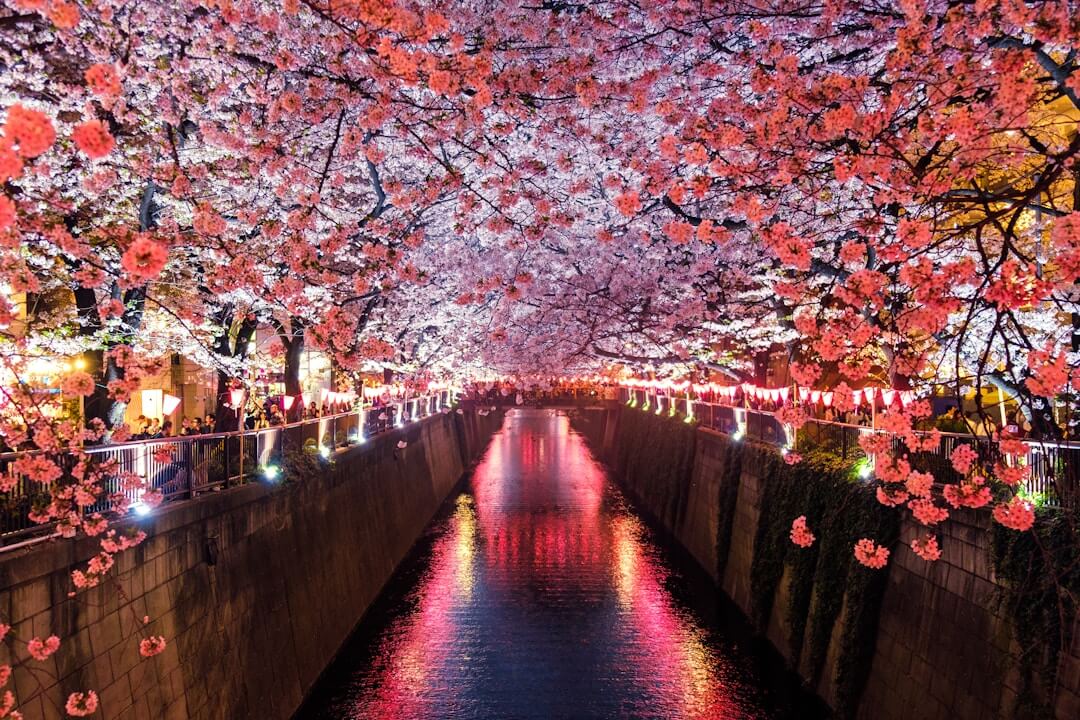
Japan may seem like an expensive destination, but with proper planning, you can manage your transportation costs effectively. From flight expenses to internal travel, understanding the financial aspects of your journey is crucial for a well-planned trip.
Estimating Flight Costs from Different Regions
The cost of flying to Japan varies significantly depending on your departure location. Here’s what you can generally expect to pay for round-trip economy flights:
| Departure Region | Average Cost Range (USD) | Typical Flight Duration |
|---|---|---|
| North America | $800-1,500 | 10-14 hours |
| Europe | $700-1,300 | 11-15 hours |
| Australia | $600-1,200 | 8-10 hours |
| Southeast Asia | $300-700 | 5-7 hours |
| South Korea | $150-400 | 2-3 hours |
North American travelers typically face the highest costs, with flights from the west coast (Los Angeles, Vancouver) being more affordable than those from the east coast (New York, Toronto). Direct flights from cities like Chicago, Dallas, or Atlanta fall somewhere in between.
European travelers might find better deals from major hubs like London, Paris, Frankfurt, and Amsterdam, which offer direct services to multiple Japanese airports.
Australian travelers benefit from relatively shorter flights compared to Western countries, with direct options from Sydney, Melbourne, and Brisbane.
Southeast Asian travelers enjoy some of the most affordable options, with numerous budget airlines serving Japan from Singapore, Bangkok, Manila, and Kuala Lumpur.
Seasonal Price Variations
Japan experiences significant fluctuations in flight prices throughout the year, directly tied to its peak tourist seasons:
- Peak Season (Most Expensive):
- Late March to early April (cherry blossom season)
- Mid-October to late November (autumn foliage)
- Mid-December to early January (New Year holidays)
- Shoulder Season (Moderate Prices):
- May (after Golden Week)
- June
- September
- Early December
- Low Season (Best Deals):
- Late January to February
- July (except Obon festival period)
- August (very hot, but avoid Obon week)
“I saved nearly 40% on my flight by visiting Japan in late January instead of during cherry blossom season. The winter landscapes were beautiful in their own right, and I enjoyed fewer crowds at major attractions.” – Experienced Japan traveler
Booking your flight 3-6 months in advance typically yields the best balance of availability and price, regardless of season.
Budget vs Premium Airlines
Your choice of airline significantly impacts both your comfort and budget:
Budget Airlines Serving Japan
Several low-cost carriers offer flights to Japan, including:
- AirAsia X (from Southeast Asia)
- Scoot (from Singapore and other Asian cities)
- Jetstar (from Australia and Asia)
- Zipair (from select US cities and Asia)
- Peach Aviation (primarily Asian routes)
These airlines can offer fares 30-50% lower than full-service carriers but typically:
- Charge extra for meals, baggage, and seat selection
- Have less legroom and basic amenities
- May fly to secondary airports (though in Japan, even budget airlines mostly use major airports)
Premium Airlines
Full-service carriers like Japan Airlines (JAL), All Nippon Airways (ANA), Singapore Airlines, Cathay Pacific, and Korean Air offer:
- Included meals, entertainment, and baggage
- Better legroom and comfort
- More reliable schedules and better handling of delays
- Frequent flyer programs with valuable benefits
- Often more direct routing options
For flights longer than 8 hours, the additional comfort of premium airlines might be worth the extra cost, especially if you can use miles or points to offset expenses.
Money-Saving Tips for Transportation
For International Flights:
- Use flight comparison tools like Google Flights, Skyscanner, or Momondo to identify the best deals across multiple airlines.
- Consider nearby departure airports – sometimes flying from a different city can save hundreds of dollars.
- Look into open-jaw tickets (flying into one Japanese city and out of another) to avoid backtracking and save on domestic travel.
- Be flexible with dates – even shifting your travel by a few days can result in significant savings.
- Sign up for fare alerts from airlines that frequently serve Japan routes.
- Consider stopovers – flights with layovers in Seoul, Hong Kong, or Taipei are often cheaper than direct options.
For Travel Within Japan:
- Evaluate if the Japan Rail Pass is worth it for your specific itinerary – it’s not always the most economical option for limited travel.
- Look into regional rail passes if your travel is concentrated in specific areas.
- Consider overnight buses for longer domestic journeys to save on accommodation costs.
- Book domestic flights in advance – airlines like Peach, Jetstar Japan, and Skymark often offer significant early-booking discounts.
Total Transportation Budget Considerations
When budgeting for transportation to and within Japan, account for these major components:
- International flights: Your largest single expense ($300-1,500 depending on origin)
- Airport transfers:
- Narita to Tokyo: $10-40 depending on method
- Kansai to Osaka/Kyoto: $10-35
- Centrair to Nagoya: $8-25
- Intercity travel:
- Japan Rail Pass (7-day): $270 (economy)
- Individual bullet train tickets: $100-180 per long-distance journey
- Budget domestic flights: $50-150 per segment
- Local transportation:
- Metro/subway: $1.50-3 per trip
- Local buses: $2-4 per trip
- Taxis: Starting around $6 plus $4-5 per kilometer
Sample Transportation Budget for a 10-day trip from the US:
- International flight: $1,000
- Airport transfers: $60 (round-trip)
- 7-day JR Pass: $270
- Local transportation: $150
- Total: Approximately $1,480
By planning strategically and booking in advance, you can significantly reduce these costs. Remember that transportation represents just one portion of your overall Japan travel budget, but it’s often the area where savvy planning can yield the greatest savings.
Best Times to Book Flights to Japan

Finding the best deals on flights to Japan requires strategic timing and planning. The optimal booking window for flights to Japan is typically 3-5 months before your intended travel date. This sweet spot often yields the best combination of availability and competitive pricing.
Seasonal Considerations
Japan experiences distinct high and low seasons that significantly impact flight prices:
| Season | Months | Flight Prices | Notes |
|---|---|---|---|
| Peak Season | Late March-May (Cherry Blossom) October-November (Autumn Foliage) | Highest | Book 5-6 months in advance |
| Summer Season | June-August | High | School holidays drive up prices |
| Low Season | January-February June (rainy season) | Lowest | Best deals, but weather may be less ideal |
| Shoulder Season | September Early December | Moderate | Good balance of price and weather |
Day and Time Strategy
The day of the week you book and fly can make a noticeable difference in what you pay:
- Best days to book: Tuesday and Wednesday afternoons (when airlines often release sales)
- Best days to fly: Tuesday, Wednesday, and Saturday (typically less expensive)
- Worst days to fly: Friday and Sunday (usually most expensive)
Fare Monitoring Tools
Take advantage of technology to secure the best possible deal:
- Set up price alerts on platforms like Google Flights, Skyscanner, or Kayak
- Use flexible date search to identify the cheapest travel periods
- Consider multi-city options or separate one-way tickets if they offer better value
- Look for deals during airline sales periods, which often occur in January, May, and September
“Being flexible with your travel dates can save you up to 30% on flights to Japan, especially if you can avoid national holidays in both your departure country and Japan.”
Airline Considerations
Different airlines offer varying levels of comfort, service, and pricing for Japan routes:
- Japanese carriers (JAL, ANA) typically offer excellent service but may be pricier
- Major international carriers often have competitive rates on Japan routes
- Budget airlines like Scoot, Jetstar, and Peach Aviation offer no-frills options for significant savings
Remember that booking too far in advance (more than 6 months) rarely results in the best deals, as airlines typically haven’t started their competitive pricing adjustments for those dates yet.
Dealing with Jet Lag
Japan’s time zone (JST, UTC+9) can cause significant jet lag for international travelers, especially those coming from North America or Europe.
Effective jet lag management can make the difference between enjoying your first days in Japan or losing them to exhaustion and disorientation.
Before Your Flight
Start preparing your body before you even board the plane:
- Begin adjusting your sleep schedule gradually 3-5 days before departure, shifting 1-2 hours each day toward Japan time
- Stay well-hydrated in the days leading up to your flight
- Avoid alcohol and caffeine for 24 hours before flying
- Consider taking melatonin supplements after consulting with your doctor
During Your Flight
Your in-flight strategy can significantly reduce jet lag symptoms:
- Set your watch to Japan time immediately after boarding
- Stay hydrated throughout the flight (aim for 8oz of water every hour)
- Limit alcohol and caffeine consumption, which can disrupt sleep patterns
- Use noise-canceling headphones and an eye mask to improve sleep quality
- Move around the cabin regularly to maintain circulation
- Consider wearing compression socks for long-haul flights
Upon Arrival in Japan
Your actions in the first 24-48 hours are crucial for minimizing jet lag:
- Expose yourself to natural sunlight immediately upon arrival to help reset your circadian rhythm
- Stay awake until a reasonable local bedtime (at least 9:00 PM), even if you’re exhausted
- Avoid napping longer than 20-30 minutes during the day
- Eat meals according to local time, not when your body feels hungry
- Consider a light exercise routine to help regulate your body clock
- Avoid heavy meals close to bedtime
“The 10-10-3-2-1-0 rule can be effective: No caffeine 10 hours before bed, no alcohol 3 hours before bed, no food 2 hours before bed, no work 1 hour before bed, and no snooze button (0) when waking up.”
Recovery Timeline
Understanding what to expect helps manage expectations:
| Day | Typical Symptoms | Recommended Actions |
|---|---|---|
| 1-2 | Extreme fatigue, disorientation | Force yourself to stay on local schedule |
| 3-4 | Improved daytime alertness, disrupted sleep | Maintain consistent sleep/wake times |
| 5-7 | Gradual normalization | Continue healthy sleep habits |
For eastbound travel (like from the US to Japan), jet lag typically lasts about one day per time zone crossed. Westbound travel (Europe to Japan) often results in slightly less severe jet lag.
Essential Apps for Traveling in Japan
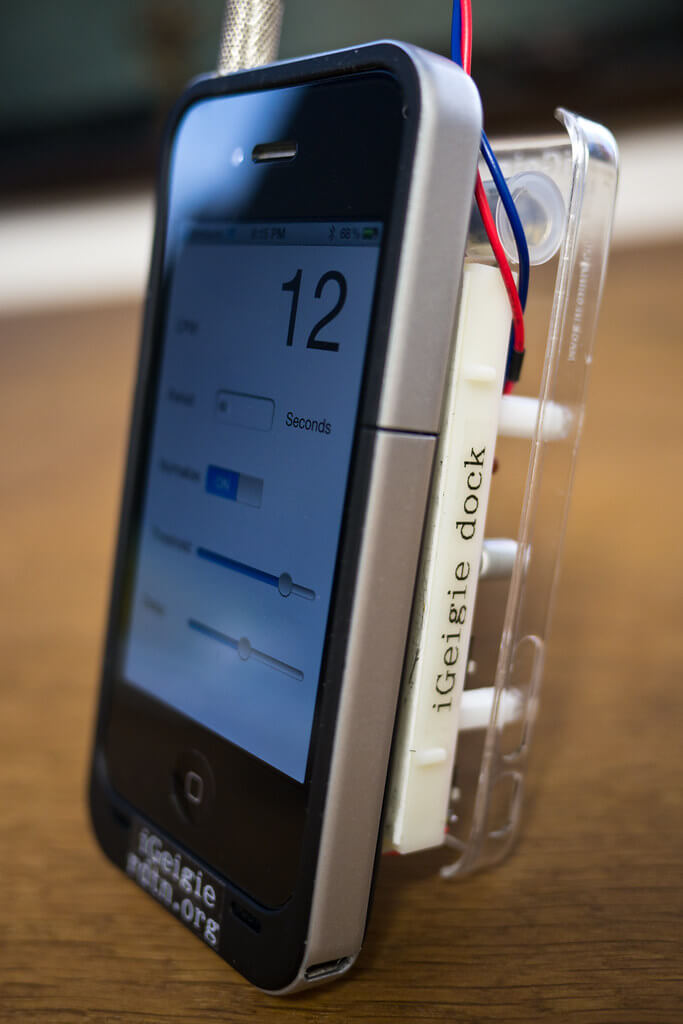
Navigating Japan becomes significantly easier with the right digital tools at your fingertips. These must-have apps will enhance your travel experience and help overcome common challenges.
Navigation & Transportation
Japan’s complex transportation network becomes manageable with these essential apps:
- Google Maps: Offers excellent coverage of Japan’s public transportation, walking directions, and points of interest
- Japan Transit Planner: Provides detailed train and subway routes, schedules, and fare information
- JR East Train Info: Real-time updates on JR line trains, including delay information
- Navitime for Japan Travel: Comprehensive transportation app with offline capabilities
- Tokyo Subway Navigation: Specialized for navigating Tokyo’s complex subway system
Language & Communication
Bridge the language gap with these powerful translation tools:
- Google Translate: Essential for translating signs, menus, and conversations with camera, voice, and text features
- Papago: Often provides more natural Japanese translations than Google Translate
- imiwa?: Comprehensive Japanese dictionary with example sentences and kanji lookup
- Waygo: Instantly translates Japanese text without internet connection
Money & Payments
Manage your finances efficiently with these financial apps:
- XE Currency: Real-time currency conversion
- PayPay: Popular Japanese payment app accepted at many establishments
- Suica/PASMO: Digital versions of transportation cards that can also be used for purchases
- LINE Pay: Widely accepted digital payment system in Japan
Travel Experience
Enhance your overall experience with these specialized tools:
- Japan Official Travel App: Comprehensive travel guide with emergency information
- Tabelog: Japan’s premier restaurant review app (similar to Yelp)
- Hyperdia: Detailed train timetables and route planning
- GuruNavi: Find restaurants with English menus
- Japan Wi-Fi Connect: Locates and connects to free Wi-Fi hotspots throughout Japan
“Before your trip, download apps that work offline or with minimal data, as public Wi-Fi in Japan can be limited outside major cities and tourist areas.”
Emergency & Safety
Be prepared for any situation with these safety-focused apps:
- Japan Official Disaster Portal: Real-time emergency alerts and evacuation information
- Safety tips: Multilingual emergency alerts for earthquakes, tsunamis, and other disasters
- Embassy Location: Find your country’s embassy or consulate in case of emergency
Most of these apps offer English interfaces, making them accessible to international travelers. Consider downloading and testing these apps before your departure to ensure they work properly and you understand how to use them effectively.
Language Barriers and Communication Tips

While Japan offers an incredibly rich travel experience, language differences can present challenges for visitors. Understanding how to navigate these barriers will significantly enhance your journey through this fascinating country.
Common Language Realities
It’s important to have realistic expectations about English proficiency in Japan:
- English signage is common in major cities, transportation hubs, and tourist attractions
- English proficiency varies widely among Japanese people, with younger generations typically having better skills
- Service staff at international hotels, major tourist sites, and global chain restaurants often speak basic English
- Rural areas and small local establishments typically have minimal English capabilities
- Written English is more common than spoken English
Essential Japanese Phrases
Learning a few key phrases demonstrates respect and can make daily interactions much smoother:
| Japanese Phrase | Pronunciation | English Meaning |
|---|---|---|
| こんにちは | Kon-ni-chi-wa | Hello |
| ありがとうございます | A-ri-ga-tou go-za-i-ma-su | Thank you very much |
| すみません | Su-mi-ma-sen | Excuse me / I’m sorry |
| お願いします | O-ne-gai shi-ma-su | Please |
| はい / いいえ | Hai / Ii-e | Yes / No |
| 英語を話せますか? | Ei-go o ha-na-se-ma-su ka? | Do you speak English? |
| トイレはどこですか? | To-i-re wa do-ko de-su ka? | Where is the bathroom? |
| いくらですか? | I-ku-ra de-su ka? | How much is it? |
Non-Verbal Communication Strategies
When words fail, these approaches can help bridge the gap:
- Point and gesture respectfully to indicate what you need
- Use visual aids like pictures on your phone of items you’re looking for
- Write down destinations in Japanese characters to show taxi drivers or locals
- Carry a pocket dictionary or translation app for quick reference
- Practice patience and speak slowly rather than loudly
“In Japan, a smile and a respectful bow can communicate gratitude and respect when words aren’t sufficient. Non-verbal communication often transcends language barriers.”
Technology Solutions
Modern technology offers powerful tools to overcome language challenges:
- Translation apps with camera functions can instantly translate menus and signs
- Pocket Wi-Fi or a local SIM card ensures constant access to translation tools
- Pre-downloaded offline translations for areas with limited connectivity
- Voice translation apps like Google Translate’s conversation mode for real-time communication
When Communication Breaks Down
Even with preparation, you may encounter situations where communication is difficult:
- Seek out younger people who are more likely to have studied English
- Visit tourist information centers where staff typically speak English
- Contact your hotel concierge for assistance with reservations or directions
- Use simple, clear English without idioms or complex grammar
- Be patient and appreciative of any assistance offered
Remember that many Japanese people may understand more English than they feel comfortable speaking. A respectful approach and willingness to work through communication challenges will almost always result in positive interactions.
Cultural Etiquette for First-Time Visitors
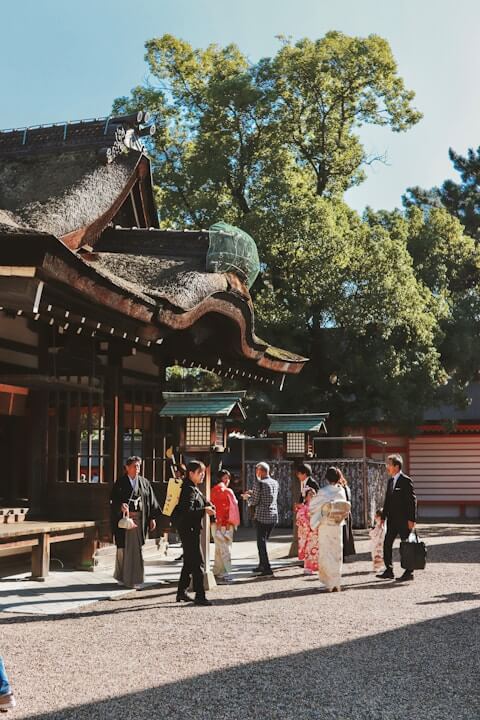
Understanding and respecting Japanese cultural norms is essential for a positive travel experience. Japan’s unique etiquette practices reflect its values of harmony, respect, and consideration for others.
Following these guidelines will help you navigate social situations with confidence and show respect for local customs.
Greeting and Meeting People
First impressions matter greatly in Japanese culture:
- Bowing is the traditional greeting—a slight bow (about 15 degrees) is appropriate for most tourist interactions
- Handshakes are becoming more common with foreigners, but follow the local person’s lead
- Business cards (meishi) are exchanged with both hands and a slight bow, if offered
- Personal space is valued—avoid excessive physical contact or standing too close
- Use both hands when giving or receiving items as a sign of respect
Dining Etiquette
Japanese food culture involves numerous etiquette practices:
- Say “itadakimasu” (I gratefully receive) before eating and “gochisousama deshita” (thank you for the meal) after finishing
- Never stick chopsticks vertically in rice (this resembles funeral rituals)
- Avoid passing food from chopstick to chopstick (another funeral association)
- Slurping noodles is acceptable and even appreciated as a sign of enjoyment
- Pour drinks for others in your group, not for yourself
- Tipping is not expected and may cause confusion—excellent service is the standard
Temple and Shrine Etiquette
When visiting Japan’s spiritual sites:
- Bow slightly when entering and leaving sacred spaces
- Follow purification rituals at the entrance (typically washing hands and mouth)
- Speak quietly and be respectful of worshippers
- Remove hats when entering buildings
- Follow photography rules carefully—some areas prohibit photos
- Avoid touching religious objects unless invited to do so
“At Shinto shrines, you’ll often see visitors toss a coin into the offering box, bow twice, clap twice, make a wish or prayer, and bow once more. This ‘2-2-1’ pattern is a common ritual worth observing.”
Public Behavior
Maintaining harmony in public spaces is highly valued:
| Do | Don’t |
|---|---|
| Keep conversations quiet on public transport | Talk loudly on phones in public places |
| Wait in orderly lines | Eat while walking on the street |
| Remove shoes when indicated | Point directly at people |
| Cover tattoos in public baths | Blow your nose in public |
| Be punctual for appointments | Litter (trash cans are scarce but carry your trash) |
Home Visits
If invited to a Japanese home:
- Bring a small gift (quality sweets or items from your home country work well)
- Remove shoes at the entrance and wear the slippers provided
- Compliment the home but avoid excessive praise that might embarrass your host
- Follow your host’s lead regarding seating arrangements and customs
Accommodating Foreign Visitors
It’s worth noting that most Japanese people:
- Don’t expect perfection from foreign visitors regarding etiquette
- Appreciate sincere efforts to respect local customs
- Are often understanding of cultural differences
- May be too polite to correct etiquette mistakes
Making an effort to learn and follow these cultural practices demonstrates respect and will enhance your experience in Japan.
When in doubt, observe what locals are doing and follow their example. A humble attitude and willingness to learn will be appreciated far more than perfect execution of every cultural nuance.
Specialized Travel Considerations for Japan
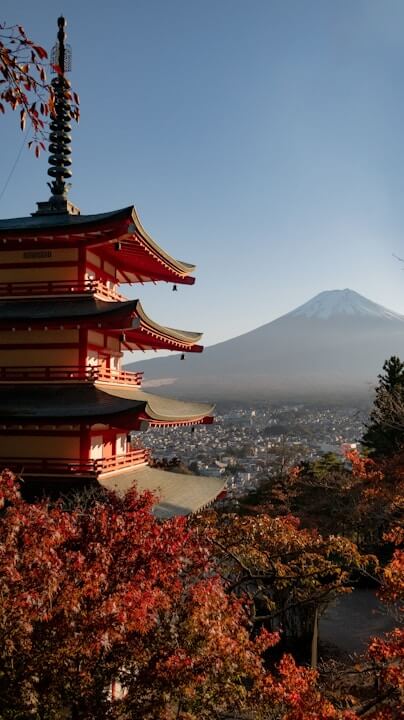
Japan welcomes all types of travelers, but certain groups may need specific information to ensure a smooth and enjoyable journey.
Whether you’re traveling with family, have accessibility needs, are a solo female traveler, on business, or exploring on a budget, here’s what you should know.
Family Travel to Japan with Children
Japan is remarkably family-friendly, offering numerous attractions and amenities for those traveling with children.
Child-Friendly Accommodations
- Many hotels offer family rooms with multiple beds or connecting rooms
- Consider booking ryokans (traditional Japanese inns) that welcome children for a cultural experience
- Family-friendly Airbnb options are abundant in major cities
Transportation with Kids
- Children under 6 ride free on most public transportation (when not occupying a seat)
- Children aged 6-11 typically pay half fare on trains, buses, and subways
- The Japan Rail Pass offers discounted rates for children
- Baby strollers are welcome on public transportation, though trains can get crowded during rush hour
Family Activities
- Tokyo Disneyland and DisneySea are world-class theme parks
- The Ghibli Museum in Mitaka celebrates beloved Japanese animation
- Interactive museums like the National Museum of Emerging Science and Innovation (Miraikan) offer hands-on exhibits
- Kid-friendly animal experiences include snow monkeys in Nagano and deer in Nara Park
Practical Tips
- Bring a baby carrier as some historical sites have stairs and uneven surfaces
- Public changing tables are available in most department stores and shopping centers
- Many restaurants offer children’s menus or smaller portions upon request
- Consider renting pocket Wi-Fi for easy access to maps and translation apps
Accessibility Information for Travelers with Disabilities
Japan has made significant strides in improving accessibility, particularly in major cities and tourist areas.
Transportation Accessibility
- Major train stations have elevators and wheelchair assistance
- The Japan Rail Pass website identifies which stations have barrier-free access
- Many taxis in urban areas can accommodate wheelchairs, especially the newer “Universal Design” taxis
- Reserved seating for those with disabilities is available on most public transportation
Accessible Accommodations
- Large international hotel chains typically offer accessible rooms
- When booking, specify your accessibility needs as building standards may differ from other countries
- Some ryokans have accessible rooms, though traditional establishments may have limited options
Tourist Attractions
- Major attractions like Tokyo Skytree, Tokyo Tower, and many museums have wheelchair access
- Historical sites like temples and castles may have limited accessibility due to their design
- Many parks and gardens have paved paths suitable for wheelchairs
Helpful Resources
- The “Accessible Japan” website provides detailed information on accessibility throughout the country
- The Japan National Tourism Organization offers accessibility guides for major destinations
- Consider renting mobility equipment in Japan rather than bringing your own
Solo Female Traveler Considerations
Japan consistently ranks as one of the safest countries for solo female travelers, though certain precautions are still advisable.
Safety Tips
- Japan has an extremely low crime rate, but remain vigilant in crowded areas
- Women-only train cars are available during rush hours in major cities (look for the pink “Women Only” signs)
- Most accommodations have secure entry systems and good lighting
Accommodation Options
- Female-only floors are available in some hotels and hostels
- Business hotels offer affordable, secure single rooms
- Capsule hotels increasingly offer women-only sections
Cultural Considerations
- Dress modestly when visiting religious sites
- Public bathing (onsen) is segregated by gender
- Learning basic Japanese phrases can help navigate unexpected situations
Social Opportunities
- Group walking tours are excellent for meeting fellow travelers
- Cooking classes and cultural workshops provide social interaction
- Izakayas (Japanese pubs) are generally safe and welcoming spaces
Business Travel Tips
Japan’s business culture has distinct customs that international travelers should understand.
Business Etiquette
- Punctuality is crucial; arrive early for meetings
- Business cards (meishi) are exchanged with two hands and a slight bow
- Bring plenty of business cards with Japanese translation on the reverse side
- Gift-giving is common in business relationships; small tokens from your home country are appropriate
Accommodation and Workspace
- Business hotels offer practical amenities like in-room desks and laundry services
- Major cities have numerous co-working spaces and business centers
- Many hotels provide meeting rooms for small gatherings
Transportation for Business
- The Airport Limousine Bus offers direct service to major hotels
- Taxis are clean, reliable, and appropriate for business travel
- Consider a temporary mobile phone or SIM card for local calls
Work-Life Balance
- After-work socializing (nomikai) is an important part of business culture
- Major cities offer excellent fine dining options for business meetings
- Consider bringing omiyage (small gifts) for business associates
Student and Budget Traveler Advice
Japan can be enjoyed without breaking the bank with strategic planning and budget-conscious choices.
Affordable Accommodations
- Hostels in Japan are exceptionally clean and secure, starting around ¥2,000-3,000 per night
- Capsule hotels offer unique, budget-friendly experiences
- Business hotels provide basic, clean rooms at reasonable rates
- Consider temple lodgings (shukubo) for a cultural experience at moderate prices
Budget Transportation
- The JR Pass offers unlimited travel on JR lines and can save money for extensive travel
- Highway buses provide cheaper alternatives to bullet trains for long-distance travel
- Rental bicycles are affordable in many cities
- Walking is safe and practical in urban centers
Eating on a Budget
- Convenience stores (konbini) offer surprisingly good, affordable meals
- Look for “teishoku” set meals at local restaurants (typically ¥600-1,200)
- Standing sushi restaurants and ramen shops provide quality food at lower prices
- Department store basement food halls (depachika) reduce prices on perishable items in the evening
Free and Low-Cost Activities
- Many temples and shrines have free entry to grounds (inner buildings may charge fees)
- Public parks and gardens often have minimal or no entrance fees
- Free walking tours are available in major cities
- Museum free days typically occur once per month
Student Discounts
- International Student Identity Card (ISIC) holders can receive discounts at many attractions
- Some museums and cultural sites offer student rates with valid ID
- Youth hostels may offer additional discounts for students
- Student-specific Japan Rail Passes are available at reduced rates
By considering these specialized travel tips, visitors from all walks of life can enjoy a more comfortable, accessible, and budget-friendly journey to Japan.
Preparing for Departure: Airport Procedures When Leaving Japan
Departing Japan can be just as memorable as arriving, especially when you navigate the process smoothly. Japanese airports are known for their efficiency, but understanding the procedures ahead of time will ensure a stress-free conclusion to your Japanese adventure.
Airport Departure Procedures
Japanese airports maintain strict security protocols while emphasizing efficiency and courtesy. The standard departure process includes:
- Initial Check-in: Proceed to your airline’s counter with your passport and booking confirmation.
- Baggage Drop: After receiving your boarding pass, drop off any checked luggage.
- Immigration: Present your passport and completed departure card (usually provided by your airline).
- Security Screening: Standard security procedures apply, with liquids limited to 100ml containers in a clear plastic bag.
- Passport Control: A final verification of your travel documents before entering the departure area.
Pro tip: Major Japanese airports like Narita and Haneda have implemented automated gates for foreign travelers, significantly speeding up the departure process.
Tax Refund Process
Japan offers a tax-free shopping program that allows visitors to receive refunds on the 10% consumption tax for eligible purchases. Here’s how to claim your tax refund when departing:
- Make qualifying purchases: Items must be bought from tax-free shops (look for “Tax-Free” signs) and total more than ¥5,000 per store.
- Keep necessary documentation: Retain your passport, receipts, and tax refund forms provided by the retailers.
- Visit the tax refund counter: Located before check-in or security at major airports.
- Present your items: Unused goods must be shown to customs officials.
- Receive your refund: This can be in cash or credited back to your card, depending on the system used.
“Plan to arrive at least 45 minutes earlier than normal if you have multiple tax refund claims to process, as lines can form during peak travel seasons.”
Souvenirs and Customs Regulations
When taking a piece of Japan home with you, be mindful of customs regulations both in Japan and your destination country:
| Item Category | Typically Allowed | Restricted or Prohibited |
|---|---|---|
| Food Items | Packaged snacks, tea, instant noodles | Fresh fruits, vegetables, meat products |
| Alcohol | Up to 3 bottles (within duty-free limits) | Excessive quantities (check your country’s limits) |
| Cultural Items | Most commercially produced crafts | Antiques over 100 years old may require permits |
| Electronics | Personal use items | Products violating intellectual property laws |
Important: Japan strictly prohibits exporting certain traditional medicines containing endangered species components, ivory products, and counterfeit goods.
Check-in Time Recommendations
Japanese airports operate with precision, but allowing sufficient time ensures a relaxed departure:
- Domestic flights: Arrive 90 minutes before departure
- International flights: Arrive 3 hours before departure
- During peak travel periods (Golden Week, New Year, Cherry Blossom season): Add an extra 30-60 minutes
For flights departing from Tokyo’s Narita Airport, consider that the journey from central Tokyo can take 60-90 minutes depending on your transportation method and traffic conditions.
Final Transportation Tips
Making your way to the airport requires planning, especially with luggage:
- Airport Limousine Buses: Offer direct service from major hotels and stations to airports, with convenient luggage storage underneath.
- Express Trains: The Narita Express (N’EX) and Skyliner provide fast connections to Narita Airport, while the Tokyo Monorail and Keikyu Line serve Haneda Airport.
- Reserved Airport Taxis: More expensive but convenient for early morning departures or those with substantial luggage.
- Luggage Delivery Services: Consider sending large suitcases to the airport a day ahead using takuhaibin (delivery services) available at convenience stores and hotels.
Last-minute reminder: Before heading to the airport, double-check that you haven’t left any valuables in hotel safes and that your portable Wi-Fi device or SIM card has been returned if required.
By following these guidelines, your departure from Japan can be as organized and pleasant as the rest of your journey, leaving you with nothing but fond memories of your time in this fascinating country.

